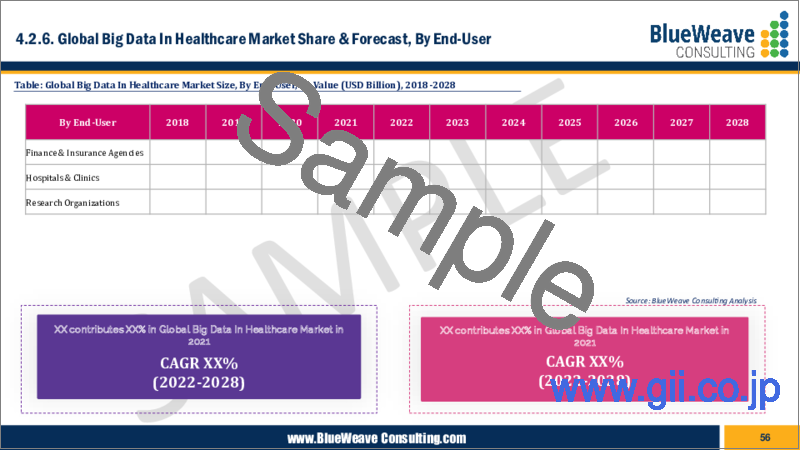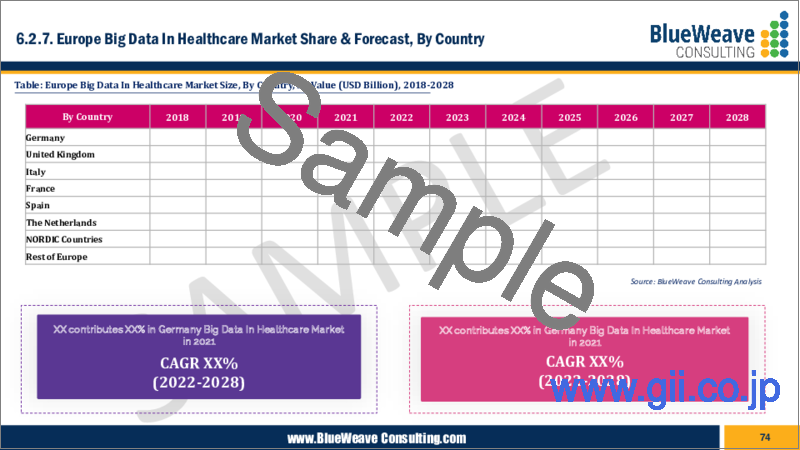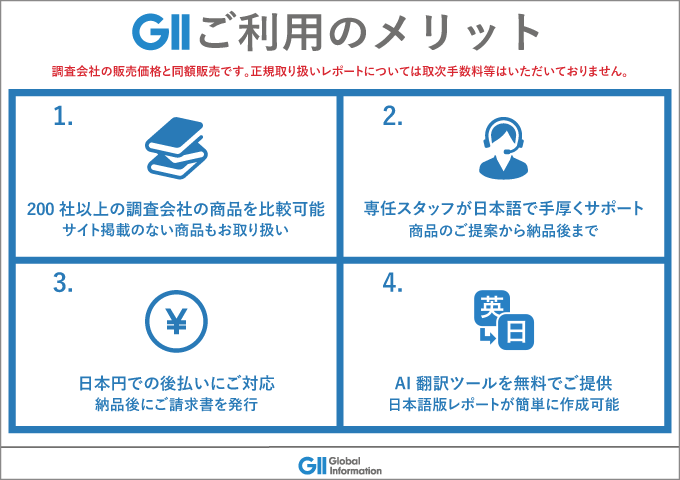|
|
市場調査レポート
商品コード
1134233
ヘルスケア向けビッグデータの世界市場 (2018年~2028年):コンポーネント・用途・展開・アナリティクスタイプ・ツールタイプ・エンドユーザー・地域別の動向分析・競合市場シェア・予測Global Big Data in Healthcare Market, By Components, By Application, By Deployment, By Analytics Type, By Tool Type, By End-User, By Region Trend Analysis, Competitive Market Share & Forecast, 2018-2028 |
||||||
| ヘルスケア向けビッグデータの世界市場 (2018年~2028年):コンポーネント・用途・展開・アナリティクスタイプ・ツールタイプ・エンドユーザー・地域別の動向分析・競合市場シェア・予測 |
|
出版日: 2022年09月22日
発行: Blueweave Consulting
ページ情報: 英文 114 Pages
納期: 2~3営業日
|
- 全表示
- 概要
- 目次
世界のヘルスケア向けビッグデータの市場規模は、2021年の281億7,000万米ドルから、予測期間中は15.9%のCAGRで推移し、2028年末には約785億2,000万米ドルの規模に成長すると予測されています。
新興経済諸国における政府の取り組み、インターネット普及率の上昇、eコマースの普及率の上昇、モバイルデバイスの普及率の上昇などが世界のヘルスケア向けビッグデータ市場の成長に寄与しています。
当レポートでは、世界のヘルスケア向けビッグデータの市場を調査し、市場概要、市場成長への各種影響因子の分析、技術動向、法規制環境、市場規模の推移・予測、各種区分・地域/主要国別の内訳、競合環境、主要企業のプロファイルなどをまとめています。
目次
第1章 調査の枠組み
第2章 エグゼクティブサマリー
第3章 世界のヘルスケア向けビッグデータ市場の洞察
- 産業バリューチェーン分析
- DROC分析
- 促進要因
- 抑制要因
- 機会
- 課題
- 技術の進歩/最近の開発
- 規制の枠組み
- ポーターのファイブフォース分析
第4章 世界のヘルスケア向けビッグデータ市場:概要
- 市場規模・予測
- 市場シェア・予測
- コンポーネント別
- サービス
- ソフトウェア
- 用途別
- 臨床分析
- 財務分析
- 運用分析
- 展開別
- クラウド
- オンプレミス
- アナリティクスタイプ別
- 記述的アナリティクス
- 診断的アナリティクス
- 予測的アナリティクス
- 処方的アナリティクス
- ツールタイプ別
- データウェアハウスアナリティクス
- 財務アナリティクス
- 生産レポーティング
- CRMアナリティクス
- 予測的アナリティクス
- ビジュアルアナリティクス
- リスク管理アナリティクス
- サプライチェーン分析
- テストアナリティクス
- エンドユーザー別
- 金融・保険代理店
- 病院・診療所
- 研究機関
- 地域別
- 北米
- 欧州
- アジア太平洋
- ラテンアメリカ
- 中東・アフリカ
- コンポーネント別
第5章 北米のヘルスケア向けビッグデータ市場
- 市場規模・予測
- 市場シェア・予測
- コンポーネント別
- 用途別
- 展開別
- アナリティクスタイプ別
- ツールタイプ別
- エンドユーザー別
- 国別
第6章 欧州のヘルスケア向けビッグデータ市場
- 市場規模・予測
- 市場シェア・予測
- コンポーネント別
- 用途別
- 展開別
- アナリティクスタイプ別
- ツールタイプ別
- エンドユーザー別
- 国別
第7章 アジア太平洋のヘルスケア向けビッグデータ市場
- 市場規模・予測
- 市場シェア・予測
- コンポーネント別
- 用途別
- 展開別
- アナリティクスタイプ別
- ツールタイプ別
- エンドユーザー別
- 国別
第8章 ラテンアメリカのヘルスケア向けビッグデータ市場
- 市場規模・予測
- 市場シェア・予測
- コンポーネント別
- 用途別
- 展開別
- アナリティクスタイプ別
- ツールタイプ別
- エンドユーザー別
- 国別
第9章 中東・アフリカのヘルスケア向けビッグデータ市場
- 市場規模・予測
- 市場シェア・予測
- コンポーネント別
- 用途別
- 展開別
- アナリティクスタイプ別
- ツールタイプ別
- エンドユーザー別
- 国別
第10章 競合情勢
- 主要企業・製品のリスト
- 企業シェア分析
- 競合ベンチマーキング:経営パラメーター別
- 主要な戦略的展開 (M&A・提携など)
第11章 COVID-19:世界のヘルスケア向けビッグデータ市場に与える影響
第12章 企業プロファイル (会社概要・財務マトリックス・競合情勢・主要人材・主な競合相手・連絡先・戦略的展望)
- Allscripts Healthcare Solutions, Inc.
- Cerner
- Cognizant
- Dell EMC
- Epic System Corporation
- Ge Healthcare
- General Electric Healthcare
- Hewlett Packard Enterprise (HPE)
- International Business Machines (IBM) Corporation
- Mckesson
- Microsoft
- Optum
- Oracle Corporation
- Philips Healthcare
- Siemens
- 他の有力企業
第13章 主な戦略的提言
第14章 調査手法
Global Big Data in Healthcare Market to Grow at a CAGR of 15.9%, during Forecast Period
Global Big Data in Healthcare Market is flourishing owing to the government initiatives in developing economies, rising internet penetration, rising e-commerce penetration, and rising availability of mobile devices all contributed to growth.
A recent study conducted by the strategic consulting and market research firm, BlueWeave Consulting, revealed that the Global Big Data in Healthcare Market was worth USD 28.17 billion in the year 2021. The market is projected to grow at a CAGR of 15.9%, earning revenues of around USD 78.52 billion by the end of 2028. The Global Big Data in Healthcare Market is booming because of the growing requirement for analysis, integration, and management of enormous volumes of data that propel big data analytics in the healthcare sector. These data are mostly gathered from different electronic health records (EHR) and patient biological information. A set of statistical algorithms and predictive models supported by high-performance analytics platforms make up big data analytics, a subset of advanced analytics. These technologies, which use powerful computing systems, provide the healthcare sector with several commercial advantages including successful marketing, new income prospects, greater operational efficiency, and better patient care. Currently, big data analytics is being adopted by a wide range of healthcare organizations, including multi-provider groups, single-physician practices, and huge hospital networks. This increase can be ascribed to the service's many benefits, which include its swift and effective detection of healthcare fraud as well as its analysis of patient information and clinical studies.
Demand for Analytics Solutions for Population Health Management is Increasing
Population health management necessitates the integration of clinical and claims data on the same platform for data analysis, resulting in complete patient care with cost-effective prescription practices. Increased demand for improved care management, early disease prediction, and hospitalization process is expected to boost the growth of the worldwide big data analytics in healthcare market in the future. Furthermore, citizen health is critical for healthcare management in the healthcare business, which necessitates predictive analysis of population health and is likely to increase big data analytics applications during the projection period.
Rise in Artificial Intelligence Demand Needs Powerful Analytics Solutions as it Builds Big Data
For several reasons, the market for big data and analytics has seen an increase in the demand for artificial intelligence (AI). AI uses natural language processing to recognize knowledge, identify different types of data, and discover potential connections between datasets. Additionally, the technology can be used to speed up and automate data preparation tasks, such as creating data models, and support data exploration for decision-making. The combination of AI and big data, according to research from 2020 Forbes, can automate close to 80% of all physical work, 70% of data processing work, and 64% of data collection tasks. By utilizing all available data, deep learning is aided by the combination of AI, big data, and analytics.
Challenge: Technical Challenges
Despite the advantages and promising future of big data in healthcare, numerous fundamental challenges remain. The technological expertise needed and the ability to ensure compliance with all security measures surrounding it are the two key barriers impeding the use of big data in healthcare. Big data necessitates particular skill sets due to the complexity of the files. Hospitals will need to seek the aid of data scientists to manipulate information in a big data environment since IT professionals who are accustomed to SQL programming and traditional databases are not prepared for the learning curve. Another significant barrier to the use of big data in healthcare is security. Big data storage is well known for luring hackers and other highly persistent dangers (APTs). Even though the majority of firms have security safeguards in place, regulations like HIPAA compliance must be protected.
Segmental Coverage
Global Big Data in Healthcare Market - By End-User
Based on end-user, the Global Big Data in Healthcare Market is segmented into Finance & Insurance Agencies, Hospitals & Clinics, and Research Organizations. Hospitals and clinic providers experienced the fastest growth. This is because hospitals and healthcare professionals were under a great deal of pressure to provide cost-effective care and better patient management during and after the pandemic, which contributed to the expansion of this end-user category. The need to maintain patient information, keep track of diseases, and provide patients with cost-effective care have all played a significant role in the widespread adoption of healthcare analytics and are expected to continue to do so.
Impact of COVID-19 on Global Big Data in Healthcare Market
The pandemic of COVID-19 had a beneficial impact on the global market for big data analytics in healthcare. This is owing to the critical need for cutting-edge technological improvements in public health, medicine, and wellness. Developments in genomes, epigenomics, transcriptomics, proteomics, metabolomics, and pharmacogenomics have supported the astounding rate of medical data collection. These data contain a plethora of information that can assist us in better understanding patient care. The growing role of big data analytics in developing predictive care models for the healthcare sector is likely to pave the way for exciting new commercial prospects.
Competitive Landscape
The leading market players in the Global Big Data in Healthcare Market are Allscripts Healthcare Solutions, Inc., Cerner, Cognizant, Dell EMC, Epic System Corporation, Ge Healthcare, General Electric Healthcare, Hewlett Packard Enterprise (HPE), International Business Machines (IBM) Corporation, Mckesson, Microsoft, Optum, Oracle Corporation, Philips Healthcare, Siemens, and other prominent players. The Global Big Data in Healthcare Market is highly fragmented with the presence of several manufacturing companies in the country. The market leaders retain their supremacy by spending on research and development, incorporating cutting-edge technology into their goods, and releasing upgraded items for customers. Various tactics, including strategic alliances, agreements, mergers, and partnerships, are used.
The in-depth analysis of the report provides information about growth potential, upcoming trends, and statistics of the Global Big Data in Healthcare Market. It also highlights the factors driving forecasts of total market size. The report promises to provide recent technology trends in the Global Big Data in Healthcare Market and industry insights to help decision-makers make sound strategic decisions. Furthermore, the report also analyzes the growth drivers, challenges, and competitive dynamics of the market.
Table of Contents
1. Research Framework
- 1.1. Research Objective
- 1.2. Type Overview
- 1.3. Market Segmentation
2. Executive Summary
3. Global Big Data in Healthcare Market Insights
- 3.1. Industry Value Chain Analysis
- 3.2. DROC Analysis
- 3.2.1. Growth Drivers
- 3.2.1.1. Growing Importance of Digital Healthcare and Interoperability
- 3.2.1.2. Increased use of wearables, mobile health, and the Internet of Medical Things (IoMT)
- 3.2.1.3. Initiative dedicated to digitizing healthcare
- 3.2.1.4. Urgent Need to Reduce Medical Expenses
- 3.2.2. Restraints
- 3.2.2.1. Security Concerns Regarding Sensitive Patient Medical Data
- 3.2.2.2. Lack of competent and knowledgeable staff
- 3.2.3. Opportunities
- 3.2.3.1. Blockchain for health information exchange
- 3.2.3.2. Achieve full medical data interoperability to support clinical decision making
- 3.2.4. Challenges
- 3.2.4.1. Data security concerns
- 3.2.4.2. Presence of large amounts of unstructured data
- 3.2.1. Growth Drivers
- 3.3. Deployment Advancements/Recent Developments
- 3.4. Regulatory Framework
- 3.5. Porter's Five Forces Analysis
- 3.5.1. Bargaining Power of Suppliers
- 3.5.2. Bargaining Power of Buyers
- 3.5.3. Threat of New Entrants
- 3.5.4. Threat of Substitutes
- 3.5.5. Intensity of Rivalry
4. Global Big Data in Healthcare Market Overview
- 4.1. Market Size & Forecast, by Value, 2018-2028
- 4.1.1. By Value (USD Billion)
- 4.2. Market Share & Forecast
- 4.2.1. By Components
- 4.2.1.1. Services
- 4.2.1.2. Software
- 4.2.2. By Application
- 4.2.2.1. Clinical Analytics
- 4.2.2.2. Financial Analytics
- 4.2.2.3. Operational Analytics
- 4.2.3. By Deployment
- 4.2.3.1. Cloud
- 4.2.3.2. On-Premises
- 4.2.4. By Analytics Type
- 4.2.4.1. Descriptive Analytics
- 4.2.4.2. Diagnostic Analytics
- 4.2.4.3. Predictive Analytics
- 4.2.4.4. Prescriptive Analytics
- 4.2.5. By Tool Type
- 4.2.5.1. Data Warehouse Analytics
- 4.2.5.2. Financial Analytics
- 4.2.5.3. Production Reporting
- 4.2.5.4. CRM Analytics
- 4.2.5.5. Predictive Analytics
- 4.2.5.6. Visual Analytics
- 4.2.5.7. Risk Management Analytics
- 4.2.5.8. Supply chain Analytics
- 4.2.5.9. Test Analytics
- 4.2.6. By End-User
- 4.2.6.1. Finance & Insurance Agencies
- 4.2.6.2. Hospitals & Clinics
- 4.2.6.3. Research Organizations
- 4.2.7. By Region
- 4.2.7.1. North America
- 4.2.7.2. Europe
- 4.2.7.3. Asia Pacific (APAC)
- 4.2.7.4. Latin America
- 4.2.7.5. Middle East and Africa (MEA)
- 4.2.1. By Components
5. North America Big Data in Healthcare Market
- 5.1.1. Market Size & Forecast by Value, 2018-2028
- 5.1.2. By Value (USD Billion)
- 5.2. Market Share & Forecast
- 5.2.1. By Components
- 5.2.2. By Application
- 5.2.3. By Deployment
- 5.2.4. By Analytics Type
- 5.2.5. By Tool Type
- 5.2.6. By End-User
- 5.2.7. By Country
- 5.2.7.1. United States
- 5.2.7.1.1. By Components
- 5.2.7.1.2. By Application
- 5.2.7.1.3. By Deployment
- 5.2.7.1.4. By Analytics Type
- 5.2.7.1.5. By Tool Type
- 5.2.7.1.6. By End-User
- 5.2.7.2. Canada
- 5.2.7.2.1. By Components
- 5.2.7.2.2. By Application
- 5.2.7.2.3. By Deployment
- 5.2.7.2.4. By Analytics Type
- 5.2.7.2.5. By Tool Type
- 5.2.7.2.6. By End-User
6. Europe Big Data in Healthcare Market
- 6.1. Market Size & Forecast by Value, 2018-2028
- 6.1.1. By Value (USD Billion)
- 6.2. Market Share & Forecast
- 6.2.1. By Components
- 6.2.2. By Application
- 6.2.3. By Deployment
- 6.2.4. By Analytics Type
- 6.2.5. By Tool Type
- 6.2.6. By End-User
- 6.2.7. By Country
- 6.2.7.1. Germany
- 6.2.7.1.1. By Components
- 6.2.7.1.2. By Application
- 6.2.7.1.3. By Deployment
- 6.2.7.1.4. By Analytics Type
- 6.2.7.1.5. By Tool Type
- 6.2.7.1.6. By End-User
- 6.2.7.2. United Kingdom
- 6.2.7.2.1. By Components
- 6.2.7.2.2. By Application
- 6.2.7.2.3. By Deployment
- 6.2.7.2.4. By Analytics Type
- 6.2.7.2.5. By Tool Type
- 6.2.7.2.6. By End-User
- 6.2.7.3. Italy
- 6.2.7.3.1. By Components
- 6.2.7.3.2. By Application
- 6.2.7.3.3. By Deployment
- 6.2.7.3.4. By Analytics Type
- 6.2.7.3.5. By Tool Type
- 6.2.7.3.6. By End-User
- 6.2.7.4. France
- 6.2.7.4.1. By Components
- 6.2.7.4.2. By Application
- 6.2.7.4.3. By Deployment
- 6.2.7.4.4. By Analytics Type
- 6.2.7.4.5. By Tool Type
- 6.2.7.4.6. By End-User
- 6.2.7.5. Spain
- 6.2.7.5.1. By Components
- 6.2.7.5.2. By Application
- 6.2.7.5.3. By Deployment
- 6.2.7.5.4. By Analytics Type
- 6.2.7.5.5. By Tool Type
- 6.2.7.5.6. By End-User
- 6.2.7.6. The Netherlands
- 6.2.7.6.1. By Components
- 6.2.7.6.2. By Application
- 6.2.7.6.3. By Deployment
- 6.2.7.6.4. By Analytics Type
- 6.2.7.6.5. By Tool Type
- 6.2.7.6.6. By End-User
- 6.2.7.7. Belgium
- 6.2.7.7.1. By Components
- 6.2.7.7.2. By Application
- 6.2.7.7.3. By Deployment
- 6.2.7.7.4. By Analytics Type
- 6.2.7.7.5. By Tool Type
- 6.2.7.7.6. By End-User
- 6.2.7.8. NORDIC Countries
- 6.2.7.8.1. By Components
- 6.2.7.8.2. By Application
- 6.2.7.8.3. By Deployment
- 6.2.7.8.4. By Analytics Type
- 6.2.7.8.5. By Tool Type
- 6.2.7.8.6. By End-User
- 6.2.7.9. Rest of Europe
- 6.2.7.9.1. By Components
- 6.2.7.9.2. By Application
- 6.2.7.9.3. By Deployment
- 6.2.7.9.4. By Analytics Type
- 6.2.7.9.5. By Tool Type
- 6.2.7.9.6. By End-User
7. Asia Pacific Big Data in Healthcare Market
- 7.1. Market Size & Forecast by Value, 2018-2028
- 7.1.1. By Value (USD Billion)
- 7.2. Market Share & Forecast
- 7.2.1. By Components
- 7.2.2. By Application
- 7.2.3. By Deployment
- 7.2.4. By Analytics Type
- 7.2.5. By Tool Type
- 7.2.6. By End-User
- 7.2.7. By Country
- 7.2.7.1. China
- 7.2.7.1.1. By Components
- 7.2.7.1.2. By Application
- 7.2.7.1.3. By Deployment
- 7.2.7.1.4. By Analytics Type
- 7.2.7.1.5. By Tool Type
- 7.2.7.1.6. By End-User
- 7.2.7.2. India
- 7.2.7.2.1. By Components
- 7.2.7.2.2. By Application
- 7.2.7.2.3. By Deployment
- 7.2.7.2.4. By Analytics Type
- 7.2.7.2.5. By Tool Type
- 7.2.7.2.6. By End-User
- 7.2.7.3. Japan
- 7.2.7.3.1. By Components
- 7.2.7.3.2. By Application
- 7.2.7.3.3. By Deployment
- 7.2.7.3.4. By Analytics Type
- 7.2.7.3.5. By Tool Type
- 7.2.7.3.6. By End-User
- 7.2.7.4. South Korea
- 7.2.7.4.1. By Components
- 7.2.7.4.2. By Application
- 7.2.7.4.3. By Deployment
- 7.2.7.4.4. By Analytics Type
- 7.2.7.4.5. By Tool Type
- 7.2.7.4.6. By End-User
- 7.2.7.5. Australia & New Zealand
- 7.2.7.5.1. By Components
- 7.2.7.5.2. By Application
- 7.2.7.5.3. By Deployment
- 7.2.7.5.4. By Analytics Type
- 7.2.7.5.5. By Tool Type
- 7.2.7.5.6. By End-User
- 7.2.7.6. Indonesia
- 7.2.7.6.1. By Components
- 7.2.7.6.2. By Application
- 7.2.7.6.3. By Deployment
- 7.2.7.6.4. By Analytics Type
- 7.2.7.6.5. By Tool Type
- 7.2.7.6.6. By End-User
- 7.2.7.7. Malaysia
- 7.2.7.7.1. By Components
- 7.2.7.7.2. By Application
- 7.2.7.7.3. By Deployment
- 7.2.7.7.4. By Analytics Type
- 7.2.7.7.5. By Tool Type
- 7.2.7.7.6. By End-User
- 7.2.7.8. Singapore
- 7.2.7.8.1. By Components
- 7.2.7.8.2. By Application
- 7.2.7.8.3. By Deployment
- 7.2.7.8.4. By Analytics Type
- 7.2.7.8.5. By Tool Type
- 7.2.7.8.6. By End-User
- 7.2.7.9. Philippines
- 7.2.7.9.1. By Components
- 7.2.7.9.2. By Application
- 7.2.7.9.3. By Deployment
- 7.2.7.9.4. By Analytics Type
- 7.2.7.9.5. By Tool Type
- 7.2.7.9.6. By End-User
- 7.2.7.10. Vietnam
- 7.2.7.10.1. By Components
- 7.2.7.10.2. By Application
- 7.2.7.10.3. By Deployment
- 7.2.7.10.4. By Analytics Type
- 7.2.7.10.5. By Tool Type
- 7.2.7.10.6. By End-User
- 7.2.7.11. Rest of Asia Pacific
- 7.2.7.11.1. By Components
- 7.2.7.11.2. By Application
- 7.2.7.11.3. By Deployment
- 7.2.7.11.4. By Analytics Type
- 7.2.7.11.5. By Tool Type
- 7.2.7.11.6. By End-User
8. Latin America Big Data in Healthcare Market
- 8.1. Market Size & Forecast by Value, 2018-2028
- 8.1.1. By Value (USD Billion)
- 8.2. Market Share & Forecast
- 8.2.1. By Components
- 8.2.2. By Application
- 8.2.3. By Deployment
- 8.2.4. By Analytics Type
- 8.2.5. By Tool Type
- 8.2.6. By End-User
- 8.2.7. By Country
- 8.2.7.1. Brazil
- 8.2.7.1.1. By Components
- 8.2.7.1.2. By Application
- 8.2.7.1.3. By Deployment
- 8.2.7.1.4. By Analytics Type
- 8.2.7.1.5. By Tool Type
- 8.2.7.1.6. By End-User
- 8.2.7.2. Mexico
- 8.2.7.2.1. By Components
- 8.2.7.2.2. By Application
- 8.2.7.2.3. By Deployment
- 8.2.7.2.4. By Analytics Type
- 8.2.7.2.5. By Tool Type
- 8.2.7.2.6. By End-User
- 8.2.7.3. Argentina
- 8.2.7.3.1. By Components
- 8.2.7.3.2. By Application
- 8.2.7.3.3. By Deployment
- 8.2.7.3.4. By Analytics Type
- 8.2.7.3.5. By Tool Type
- 8.2.7.3.6. By End-User
- 8.2.7.4. Peru
- 8.2.7.4.1. By Components
- 8.2.7.4.2. By Application
- 8.2.7.4.3. By Deployment
- 8.2.7.4.4. By Analytics Type
- 8.2.7.4.5. By Tool Type
- 8.2.7.4.6. By End-User
- 8.2.7.5. Colombia
- 8.2.7.5.1. By Components
- 8.2.7.5.2. By Application
- 8.2.7.5.3. By Deployment
- 8.2.7.5.4. By Analytics Type
- 8.2.7.5.5. By Tool Type
- 8.2.7.5.6. By End-User
- 8.2.7.6. Rest of Latin America
- 8.2.7.6.1. By Components
- 8.2.7.6.2. By Application
- 8.2.7.6.3. By Deployment
- 8.2.7.6.4. By Analytics Type
- 8.2.7.6.5. By Tool Type
- 8.2.7.6.6. By End-User
9. Middle East & Africa Big Data in Healthcare Market
- 9.1. Market Size & Forecast by Value, 2018-2028
- 9.1.1. By Value (USD Billion)
- 9.2. Market Share & Forecast
- 9.2.1. By Components
- 9.2.2. By Application
- 9.2.3. By Deployment
- 9.2.4. By Analytics Type
- 9.2.5. By Tool Type
- 9.2.6. By End-User
- 9.2.7. By Country
- 9.2.7.1. Saudi Arabia
- 9.2.7.1.1. By Components
- 9.2.7.1.2. By Application
- 9.2.7.1.3. By Deployment
- 9.2.7.1.4. By Analytics Type
- 9.2.7.1.5. By Tool Type
- 9.2.7.1.6. By End-User
- 9.2.7.2. UAE
- 9.2.7.2.1. By Components
- 9.2.7.2.2. By Application
- 9.2.7.2.3. By Deployment
- 9.2.7.2.4. By Analytics Type
- 9.2.7.2.5. By Tool Type
- 9.2.7.2.6. By End-User
- 9.2.7.3. Qatar
- 9.2.7.3.1. By Components
- 9.2.7.3.2. By Application
- 9.2.7.3.3. By Deployment
- 9.2.7.3.4. By Analytics Type
- 9.2.7.3.5. By Tool Type
- 9.2.7.3.6. By End-User
- 9.2.7.4. Kuwait
- 9.2.7.4.1. By Components
- 9.2.7.4.2. By Application
- 9.2.7.4.3. By Deployment
- 9.2.7.4.4. By Analytics Type
- 9.2.7.4.5. By Tool Type
- 9.2.7.4.6. By End-User
- 9.2.7.5. Iran
- 9.2.7.5.1. By Components
- 9.2.7.5.2. By Application
- 9.2.7.5.3. By Deployment
- 9.2.7.5.4. By Analytics Type
- 9.2.7.5.5. By Tool Type
- 9.2.7.5.6. By End-User
- 9.2.7.6. South Africa
- 9.2.7.6.1. By Components
- 9.2.7.6.2. By Application
- 9.2.7.6.3. By Deployment
- 9.2.7.6.4. By Analytics Type
- 9.2.7.6.5. By Tool Type
- 9.2.7.6.6. By End-User
- 9.2.7.7. Nigeria
- 9.2.7.7.1. By Components
- 9.2.7.7.2. By Application
- 9.2.7.7.3. By Deployment
- 9.2.7.7.4. By Analytics Type
- 9.2.7.7.5. By Tool Type
- 9.2.7.7.6. By End-User
- 9.2.7.8. Kenya
- 9.2.7.8.1. By Components
- 9.2.7.8.2. By Application
- 9.2.7.8.3. By Deployment
- 9.2.7.8.4. By Analytics Type
- 9.2.7.8.5. By Tool Type
- 9.2.7.8.6. By End-User
- 9.2.7.9. Egypt
- 9.2.7.9.1. By Components
- 9.2.7.9.2. By Application
- 9.2.7.9.3. By Deployment
- 9.2.7.9.4. By Analytics Type
- 9.2.7.9.5. By Tool Type
- 9.2.7.9.6. By End-User
- 9.2.7.10. Morocco
- 9.2.7.10.1. By Components
- 9.2.7.10.2. By Application
- 9.2.7.10.3. By Deployment
- 9.2.7.10.4. By Analytics Type
- 9.2.7.10.5. By Tool Type
- 9.2.7.10.6. By End-User
- 9.2.7.11. Algeria
- 9.2.7.11.1. By Components
- 9.2.7.11.2. By Application
- 9.2.7.11.3. By Deployment
- 9.2.7.11.4. By Analytics Type
- 9.2.7.11.5. By Tool Type
- 9.2.7.11.6. By End-User
- 9.2.7.12. Rest of Middle East & Africa
- 9.2.7.12.1. By Components
- 9.2.7.12.2. By Application
- 9.2.7.12.3. By Deployment
- 9.2.7.12.4. By Analytics Type
- 9.2.7.12.5. By Tool Type
- 9.2.7.12.6. By End-User
10. Competitive Landscape
- 10.1. List of Key Players and Their Analytics Types
- 10.2. Global Big data in healthcare Company Market Share Analysis, 2021
- 10.3. Competitive Benchmarking, By Operating Parameters
- 10.4. Key Strategic Developments (Mergers, Acquisitions, Partnerships)
11. Impact of Covid-19 on Global Big Data in Healthcare Market
12. Company Profile (Company Overview, Financial Matrix, Competitive Landscape, Key Personnel, Key Competitors, Contact Address, Strategic Outlook, SWOT)
- 12.1. Allscripts Healthcare Solutions, Inc.
- 12.2. Cerner
- 12.3. Cognizant
- 12.4. Dell EMC
- 12.5. Epic System Corporation
- 12.6. Ge Healthcare
- 12.7. General Electric Healthcare
- 12.8. Hewlett Packard Enterprise (HPE)
- 12.9. International Business Machines (IBM) Corporation
- 12.10. Mckesson
- 12.11. Microsoft
- 12.12. Optum
- 12.13. Oracle Corporation
- 12.14. Philips Healthcare
- 12.15. Siemens
- 12.16. Other Prominent Players
13. Key Strategic Recommendations
14. Research Methodology
- 14.1. Qualitative Research
- 14.1.1. Primary & Secondary Research
- 14.2. Quantitative Research
- 14.3. Market Breakdown & Data Triangulation
- 14.3.1. Secondary Research
- 14.3.2. Primary Research
- 14.4. Breakdown of Primary Research Respondents, By Region
- 14.5. Assumptions & Limitations




